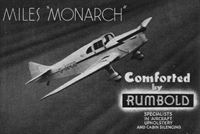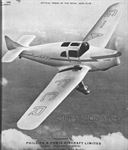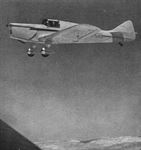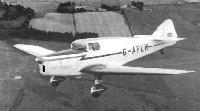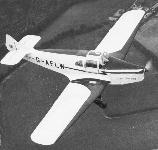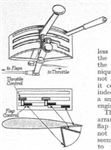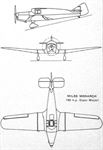Flight, June 1938
THE MILES MONARCH
One Step Nearer the Ideal : Practical Approach Adjustment : Error-proof Flap Control : Some Impressions of the Three-seater Version
By H. A. TAYLOR
WITH the incidence of the rearmament programme, the free flying provided by the Reserve schools, and his own lackadaisical attitude during the past few years, the amateur pilot is finding himself less and less effectively provided for. In fact, suitable machines for his use which are at present being made can probably be counted on the fingers of one hand.
He has, I fear, only himself to blame and he can be considered lucky that a few manufacturers think that he is in any way worthy of special notice. For a number of years he has been subsidised to quite a fair degree by generous firms who have continued to produce machines for him, sometime at considerable loss, and no one can blame the firms if, faced with the prospect of the most magnificent armament prizes, they leave the amateur to find his own salvation.
Nevertheless, it surely behoves those firms to continue, where production considerations make it possible, to plough a little of their new prosperity into civil development so that eventually - perhaps after the arrival of the millennium - they may reap some sort of harvest. Phillips and Powis actually started with the civil market, and, though busy enough now on Air Ministry contracts, Mr. Miles does not intend to forget this market. For the moment his plan for bigger and better transport aeroplanes are necessarily in abeyance, but in the new Monarch he has gone one better than last year’s most interesting newcomer in the smaller class - the Whitney Straight.
Outwardly the Monarch may be considered simply as an improved Straight, and its flying characteristics are almost entirely similar. But, quite apart from detail improvements and the fact that it is available as a three-seater, this machine has something for which one of Flight’s contributors has been crying out during the last two years or more - to wit, means of safe approach adjustment without the use of the engine. With this simple but effective item of equipment, the Monarch may be considered to mark a new stage in development from the ordinary pilot's point of view.
The method of arranging this “glide control” does not involve the use of air-brakes as such, but simply of making the best of present material in the form of straightforward split flaps. During the greater part ol their movement these Theed vacuum-operated flaps are acting purely as air brakes and beyond a certain angle further action does not cause a change in the characteristics of the machine.
Basically, the glide-control scheme involves the use of a gate for the flap-control lever, this gate preventing the pilot from bringing the flaps straight up in one movement. At the gated position of the lever the flaps are at an angle ol 25 degrees - that of maximum lift. Additionally, however, the lever is interconnected with the throttle so that when the latter is opened the flaps are raised to the 25-degree position, where they remain (during a second circuit or plain rumble) until the pilot feels that it is safe to raise them completely.
In practice, this interconnection not only prevents the pilot from attempting to take off with the flaps in the fully down position, but also removes practically all the additional drag immediately the throttle is opened - which may be because an obstruction in the line of approach has been seen or because the landing area is just being badly undershot. Between the gate and the full-flap position the control can safely be moved to adjust the angle of approach as the aerodrome boundary appears to be nearer or farther away.
All of which, in verbal explanation, may seem to be complicated, but actually it is the simplest of all devices. In the machine which I flew the throttle was not connected to the flap control, though the more essential gate arrangement was in full working order. The only difference was that the interconnection had to be provided manually by grasping both levers at the same time; since they are next door to one another this was no hardship. As it happened, I did not at any time while flying the machine undershoot so unexpectedly that the interconnection would have been really helpful. In fact, I was suffering all day from an attack of over-caution and consequent slight over-shootment, so that at least once it was necessary to apply the sometimes disbelieved and discouraged technique of a semi-stalled glide with the flaps right down. This method works extremely well if there is any breeze blowing and, provided that some additional speed is obtained before the actual touch-down, it is both safe and practical with a machine which has ample control at low speeds and which shows no tendency to drop a wing. For some very good reason concerned with airflow both the Monarch and the Straight are rigidly stable near the stall with the flaps down, but perform more or less conventionally with the flaps up. Whether the sink-approach technique is seriously used or not in normal operations, it could be very helpful indeed when approaching a small field with a dead engine.
The importance of arranging throttle and flap interconnection cannot be overstressed. It seems to be a small thing to move an additional lever, but when height is suddenly required there is often little time to remember quite what should be done. Furthermore, it is most certainly possible to take off accidentally with the flaps right down in spite of the fact that there may be a large mechanical indicator on the dashboard. The Monarch will climb quite well with the flaps fully down, but only at an air speed of less than 50 m.p.h. and at the flying angle which seems, to the uninitiated, to be most perilous.
Filled with the false courage of the experimental scientist I once attempted to take a Straight off in this condition. The machine left the ground after quite a normal run, but, once in the air, it felt so much as if a piece of strong elastic had been tied to the tail-wheel that all my courage evaporated at once, and I made an immediate landing on what was left of the aerodrome ahead of the machine. With the flaps in the 25-degree position, however, no drag is noticeable until
the air speed has risen to the three-figure mark.
The Monarch can be flown comfortably and continuously on the stick alone, and it is possible to go from one vertical bank to another without any appreciable yawing motion during the change-over. Where course flying is concerned the machine will fly equally well on its rudder alone, but, rather naturally, any serious turning by this means alone involves some elevator assistance if the nose is to be prevented from dropping. The new type is fitted with rudder bias gear operated by a transverse lever at the base of the dashboard, and this permits the machine to be set on a straight course at any selected engine and air speed.
Left to itself in the somewhat bumpy air at lower levels the demonstrator Monarch, after a short time, dropped its port wing and inevitably started a slow turn to the left. On climbing above the cloud layer at 6,000ft., however, the machine could be left to its own devices for quite long periods once the throttle position had been arranged to suit the fore-and-aft trim, which is adjusted, as before, by means of a ratchet-position lever, operating a spring tensioner. This lever, incidentally, no longer tends to jump disconcertingly into the full nose-heavy position; the ratchet is controlled by a press-button on the top of the lever and the whole operation of trim adjustment is a great deal easier on this machine than on its forerunner. During a cross-country between Shoreham and Reading the machine was left to itself in the smooth air at 7,000ft. for as long as five minutes at a time, and at the same height earlier in the day I had changed seats with Mr. Skinner, the Phillips and Powis test pilot, without suffering any serious misgivings.
This change-over was made comfortably possible by the use of the third seat with which the Monarch can be arranged. Although this seat does not, at first sight, appear to be over-roomy, it is, in fact, extremely comfortable, with plenty of space for one’s knees. It actually takes the place of half the normal two-seater’s luggage compartment and, in the interests of comfort and absolute certainty, the makers recommend a limit of 200 lb. in the load behind the two front seats. Which means, in practice, that a normal third passenger as well as forty or fifty pounds of luggage can be accommodated without any awkward slow-speed effects. With one person, or even two, aboard, it is practically impossible to stall the Monarch from normal flight, but with an overload in the aft position its characteristics become somewhat more conventional, and the recommended safe limit of loading should be adhered to as far as possible. This loading, however, permits two people to carry more luggage than they could possibly require on any reasonably protracted tour. The standard equipment of the three-seater includes a metal airscrew.
For the benefit of this third occupant an extra window has been fitted on the starboard side, from which, for the same reason, the upward-folding door now opens. This door has its hinges well beyond the centre line of the roof so that there need be no contortions while entering or leaving the machine. For emergency exits a quick-release catch has been fitted so that the major part of the door can be dropped away; additionally, the rear roof window can be used, and it should be mentioned that the part of the door which falls out would not be in contact with the ground in case of a nose-over. The sliding side windows are held in the closed position by means of a locker-type catch, and this fact, coupled with that of greater thickness for the materials of the windows themselves, has some bearing on the additional measure of silence which has been obtained in the Monarch. The only appreciable amount of noise in its forerunner - and that inoffensive - was caused by airflow and its resulting vibrations.
A slight but nevertheless important change in the one-piece windscreen has also been made. This is now deeper and the scuttle has been slightly lowered in relation to the seats, with the result that the view both on the ground and in the air is very much improved. Although the cabin design as a whole appears to be almost unchanged, the amount of headroom has also been increased. A point which should really have been mentioned while the awful possibility of emergency departures was being considered is that the tubular seats have been designed to take, by the removal of the rear cushions, the standard Irvin back-type parachutes. Alternatively, the chair-type can be installed without modification.
Those who have discovered exactly how hot a low-wing cabin machine can become under a normal sun; and even when flying in air which is a good deal below zero in temperature, will approve of the simple louvre-type ventilator in the scuttle; this can be adjusted to provide anything from a whiff of cool air to a blast of icy wind which is, nevertheless, directed and dissipated in such a way that no discomfort is involved.
Altogether I spent about three hours in the air with the Monarch - hardly enough for one to feel justified in saying that all the best and the worst has been discovered. but quite enough to make one realise that these light aeroplanes really are improving and becoming more and more easy and foolproof in their general performance. Despite quite prodigious orders for the Kestrel Trainer and the Magister, Phillips and Powis are going to turn out the Monarch in the sort of numbers that should cover the comparatively small present market for such a machine; which is at least the way to retain a name in the almost forgotten world of civil aeroplanes. To-morrow the name will be needed, and in the meantime here is something outstanding for the private owner, the club or the charter operator.
EQUIPMENT
The Gipsy Major engine has either a wooden airscrew by the Airscrew Co., Ltd., or a Fairey metal airscrew, and is fitted with a Claudel-Hobson carburettor, B.T.H. magnetos and K.L.G. sparking plugs; ignition cable is by Johnson and Phillips, Ltd., and Superflexit petrol piping is used. Filters are by Auto-Klean Strainers. Ltd., and fuel cocks by Vickers (Aviation), Ltd.. Smiths instruments are used, while Reid and Sigrist turn-and-bank indicator and Sperry blind-flying instruments can be fitted.
Saro plywood and Bamberger's spruce are used in the fuselage, which is covered with Titanine de luxe finish. The cabin is upholstered by Kumbold, and Perspex windscreen and Rhodoid windows are fitted
Various items in the airframe are supplied by J. Stone and Co. (alloy fittings), British Aluminium Co., Reynolds Tube Co., Ltd. (steel tubing), Herbert Terry and Co. (springs), and the British Aluminium Co. (aluminium). Simmonds elastic stop nuts are used, while A.G.S. parts are supplied by Brown Brothers (Aircraft), Ltd.
Sir George Godfrey and Partners make the flap gear. Control cables are by Bruntons (Musselburgh), and ball bearings by Skefko and Hoffmann. Automotive Products, Ltd., are responsible for the undercarriage legs, and the Bendix Co. the brakes, while the wheels and tyres are Dunlop. Airwork, Ltd., are the sole agents in Great Britain.
THE MILES MONARCH
130 h.p. Gipsy Major Engine
Span 35ft. 7in. (10.85 m.)
Length 26ft. (7.02 m.)
Weight empty (two-seater) 1,360lb. (617 kg.)
Do. (three-seater) 1,390lb. (630.5 kg.)
Normal all-up weight 2,000lb. (907 kg.)
Maximum all-up weight 2,150lb. (975 Aj.)
Maximum speed 145 m.p.h. (233 km/hr.)
Cruising speed (2,100 r.p.m.) 130 m.p.h. (200 km./hr.l
Stalling speed [flaps down) 40 m.p.h. (61.5 km/hr.)
Rate of climb 850 ft/min. (259 m./min.)
Range (30-gal. tanks; 2,100 r.p.m.) 600 miles (965 km.)
Range (44-gaI. tanks; 2,100 r.p.m.) 875 miles (1,410 km.)
Price (two-seater) £1,250.
Makers: Phillips & Powis Aircraft, Ltd., Woodley Aerodrome, Reading, Berks.
Показать полностьюShow all
Flight, October 1938
British Sport and Training types
PHILLIPS AND POWIS
INCORPORATING various modifications and improvements resulting from experience with the Miles Whitney Straight, Phillips and Powis this year produced the Miles Monarch. Since the Straight was originally intended to be, as nearly as possible, an ideal type for the private owner, it is reasonable to suppose that the new Monarch must come even nearer to this ideal.
Basically the layout is very similar, with a side-by-side two-seater cabin and ample luggage accommodation on a tray immediately behind the seats. The structure is of stressed plywood. The Monarch, however, has a somewhat roomier cabin, and it is produced in two forms, one of which is a three-seater. The moulded one-piece screen is deeper and special attention has been paid to ventilation.
Mr. Miles was one of the first British designers, if not the first, to fit split trailing-edge flaps to his machines, and in the Monarch the vacuum-operated gear has been modified to incorporate an interesting safety device, which he calls a glide control. With this device a gate is provided to prevent the flaps from being raised completely in one movement, and the throttle is interconnected with the control so that, when it is necessary to use the engine suddenly either during or after the approach, the flaps move up automatically to the 20-degree position. There is, consequently, no sink and most of the drag is removed at the moment of opening the throttle. In its new form, too, the gear permits the flap position to be changed through an infinite variety of angles. In other words, the flaps are designed to give the best possible results both as lift increasers and air brakes.
Magnesium alloy appears largely in construction of control items, and these, with other details on the machine, have received special consideration. Both performance and appearance has been improved by the use of a highly polished finish. The engine is, of course, a Gipsy Major, with a wooden airscrew for the two-seater and a metal airscrew for the three-seater.
Monarch data:- Span, 35ft. 7in.; length, 26ft.; all-up weight (two-seater). 2,000 lb., (three-seater) 2,150 lb.; weight empty (two-seater), 1.360 lb. (three-seater) 1,390 lb.; maximum speed, 145 m.p.h.; cruising speed at 2,050 r.p.m., 125 m.p.h.; stalling speed (with flaps), 40 m.p.h.; rate of climb, 850 ft./min.; normal cruising range at 2,050 r.p.m., 620 miles; cruising range with extra tankage at 2,050 r.p.m., 910 miles; and price, (two-seater) L1,250, (three- seater) L1,325.
Makers:- Phillips and Powis Aircraft. Ltd., Woodley Aerodrome, Reading. Berks (Sonning 2211).
Показать полностьюShow all






